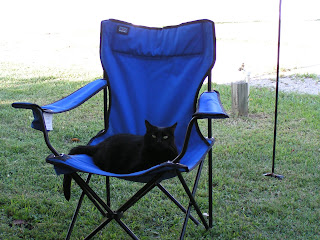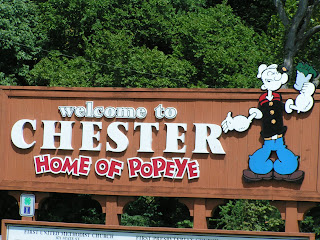August 31, 2009
What a wonderful day we’ve had! I just love it here - the people, the countryside, everything about it feels like coming home, although I can’t put a finger on why that is any more than any other corn and soybean cropland region. It just is. We have left behind the French/Creole settlements of southern Illinois and returned to ancestral lands of Indiana.
We got a late start this morning. I think Chris was tuckered after driving us over here. Granted the roads are exceptionally narrow and we did have a healthy crosswind, which makes it all that much more important to stay focused and more fatiguing. Last year, we stayed at a place called Grandpa’s Farm, which it is, nice but a bit dank and crowded. We like this home out in the country better, and are walking distance to the Wabash River. We camped on the Wabash once farther upstream and thought it looked like an interesting river. Now because of its proximity, the few lyrics I remember to “The Wabash Cannonball” continue to run through my head, will have to research to get the rest so I can at least be driven crazy by the complete song.
As we hurtled toward our ancestral homes today, we were waylaid by a marker for a wonderful old cabin near Balbec.
 Seems it was a stop on the Underground Railroad - Eliza Harris of Uncle Tom’s Cabin fame was said to have rested there on her journey to Canada. It was standing open, abandoned, so we wandered in and up the interesting wooden stairs that curve around the corner. All very intriguing, a lovely place.
Seems it was a stop on the Underground Railroad - Eliza Harris of Uncle Tom’s Cabin fame was said to have rested there on her journey to Canada. It was standing open, abandoned, so we wandered in and up the interesting wooden stairs that curve around the corner. All very intriguing, a lovely place.This time we sprayed our feet and legs before venturing into the grass. No more unprotected trekking for me. I’m very grateful the chiggers that have taken up residence around my ankles are pretty darn unitchy compared to others I’ve gotten.
From there we headed to Fairview to revisit the graves of ancestors Joseph Robert McKinney,
 Anthony Wayne McKinney Elizabeth (Bracken) McKinney, and Nancy Ann (Brown) Hoppes. I was especially interested in them because I had via telephone made arrangements for their stones to be repaired, but have not paid for the work. It has been an odd sequence of events. From recommendations, I had found a man named Matt who agreed to do the work (Anthony’s is a large tall monument and was in danger of falling over from its own leaning weight and Elizabeth’s was broken) but who had not billed me for the labor.
Anthony Wayne McKinney Elizabeth (Bracken) McKinney, and Nancy Ann (Brown) Hoppes. I was especially interested in them because I had via telephone made arrangements for their stones to be repaired, but have not paid for the work. It has been an odd sequence of events. From recommendations, I had found a man named Matt who agreed to do the work (Anthony’s is a large tall monument and was in danger of falling over from its own leaning weight and Elizabeth’s was broken) but who had not billed me for the labor.In the meantime, a glitch in transferring data from laptop to desk computer lost Matt’s contact information. Later, I located my original notations in a notebook and called him. He had done the work, he said, and would send a bill, but I’ve never received one, and now the contact seems to have once again disappeared. What a magillah! So now we know the work is completed and done very well, so we have to find him somehow???
Joseph Robert was a soldier in the American Revolution; his son Anthony Wayne
 (named for the general Joseph served under) fought in the War of 1812.
(named for the general Joseph served under) fought in the War of 1812.Next, we drove to the Hillcrest Cemetery which has the burials of more ancestors - Joseph Jefferson McKinney and his wife Elizabeth (Maitlen) McKinney, who were moved from the old Redkey graveyard. Both places have many collateral family members.
Last burying ground today took a bit more wandering, but Chris got us there - the Bethel Church graveyard where we have Sarah (Fiers) Maitlen. Sarah required a bit of casting around before we located her and put flowers on her grave as we did the others. There we did some recording and photographing of family members who had been missed last year. In order to make some of the photographs readable, we did the magic trick of putting shaving cream on the stone face and then using a squeegee to wipe it off. I did photos of before and after on some of them to show the difference.

Another unfinished business lured us back to Isaac and
 Sarah Maitlen’s farm of long ago. Chris found it for us last year. We knew from an old newspaper account that Isaac was killed in a woodcutting accident on his farm and buried there. When we stopped at the house on that farm during the previous trip, the owner was nice but too rushed to spend any time talking with us. She told us her mother-in-law grew up there and she would ask her about where Isaac’s grave might be. We never heard from them, so I was anxious to return with a bit more time to learn what we could.
Sarah Maitlen’s farm of long ago. Chris found it for us last year. We knew from an old newspaper account that Isaac was killed in a woodcutting accident on his farm and buried there. When we stopped at the house on that farm during the previous trip, the owner was nice but too rushed to spend any time talking with us. She told us her mother-in-law grew up there and she would ask her about where Isaac’s grave might be. We never heard from them, so I was anxious to return with a bit more time to learn what we could.We met the same lady (Deb); her husband (Jeff Houston) was home (laid off - a casualty of the economy) and the carpenter (James Burns) who is working on an addition to their house. We had a very enjoyable time talking with them about the history of the farm, our other area ancestors, places to fish locally and life in general. Deb called Jeff’s mother and let me talk to her on the phone. Martha Houston was very accommodating (her parents bought the place when she was in second grade; she’s now 73) but had never known where the graveyard was. Jeff had found a tombstone once while mowing, that of a child, Sidney Maitlen, whose parents are buried at Bethel.
Since that time, he has discovered a gravestone foundation in a location that we think from the 1838 account is probably the burying ground - described as on a knoll (or what passes for one in Indiana). We discussed the possibility of probing the ground in that area to try to find Isaac’s stone, and may return to do that. Jeff is amenable to that idea.
Martha knew about the burying ground as a child, remembered folks talking about it and had a vague idea of its location but never saw any stones.
It was interesting that while Jeff was ripping out insulation in the attic preparatory to adding their partial second story, he found some Maitlen names and papers attached to the wall. They seem all to be from the 1920s; he gave them to me as the nearest thing to family hereabouts.
Turns out that both men have fished and canoed the nearby Mississinewa River and that James has a good friend who owns the property our Anthony McKinney owned and lived on and where he had a dam on the river for his gristmill. We wanted to get to the site but had not because of the private property although we’ve since learned that there seems to be nothing left of the mill and just a remnant of the dam, so we didn’t really miss anything. It was my longtime dream to come here to look for that after reading about it in an old history.
Everyone was super nice, even to the point of having us pick tomatoes out of their garden before we left - yum!
I had earlier seen a sign offering Silver Queen sweet corn, a delicious variety we used to grow, so we headed there to pick up some for supper. Gardener Gene Gleeson was quite a convivial fellow and we spent substantial time chatting with him and then with his wife Darlene when she arrived. All locals, the families know each other and about the missing Maitlen graveyard. In fact, Gene has a friend who has a gravestone supposedly from there. We will have to follow up on that; Gene didn’t know the name on it.
Darlene had just returned from the doctor: she is in treatment for breast cancer, a situation that caused the couple to miss their annual winter trek to visit their two sons who live in Mesa and Gilbert, Arizona. We thought all the folks were just swell, as we have about everyone we’ve ever met here. We came away from the Gleeson’s place not only with corn, but great squash, eggplant, bell pepper and sweet onions - prime produce. Gene knows his stuff; we are picky former truck farmers and he gets our full approval.
Our shagginess led us to look for “our” haircutter in Portland. That strange story began last summer when we were here after ten weeks on the road. I had thought to let my hair grow out until I could return to Julie in Prescott. She has cut my hair for years and always does a bang-up job of it, couldn’t imagine asking a total stranger to take the shears to my head. At any rate, the growing-out routine proved to be gruesome, not to mention Chris was disappearing into the brush. Soooo, last year when I happened to notice an elderly lady in Portland who had an awesome haircut, I spontaneously asked where this total stranger had it done. She directed us to a small shop down the road that invited walk-ins, and so we did. A young lady named Amanda took us in hand then, and was there and available for us again. We are once again as presentable as we get.
Amazingly, she not only remembered the two hairy strangers, she recalled why we had come here. Now she is all abuzz about her upcoming wedding (500 invited, 7 bridesmaids) that she and her fiancé have been saving up to provide full dinner and open bar for. Holy ringbearer, Batman, that’s going to take a bundle!
Now we have seen information about Loblolly Marsh and Limberlost Swamp, so will be looking into a sizable stop there between researching in Fort Wayne and probing around on Isaac Maitlen’s farm and fishing and who knows what else.








































